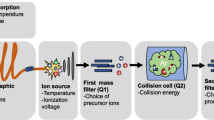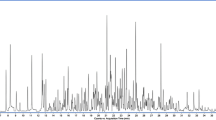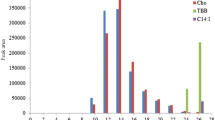Abstract
Established maximum levels for the mycotoxin zearalenone (ZEN) in edible oil require monitoring by reliable analytical methods. Therefore, an automated SPE-HPLC online system based on dynamic covalent hydrazine chemistry has been developed. The SPE step comprises a reversible hydrazone formation by ZEN and a hydrazine moiety covalently attached to a solid phase. Seven hydrazine materials with different properties regarding the resin backbone, pore size, particle size, specific surface area, and loading have been evaluated. As a result, a hydrazine-functionalized silica gel was chosen. The final automated online method was validated and applied to the analysis of three maize germ oil samples including a provisionally certified reference material. Important performance criteria for the recovery (70–120 %) and precision (RSDr <25 %) as set by the Commission Regulation EC 401/2006 were fulfilled: The mean recovery was 78 % and RSDr did not exceed 8 %. The results of the SPE-HPLC online method were further compared to results obtained by liquid–liquid extraction with stable isotope dilution analysis LC-MS/MS and found to be in good agreement. The developed SPE-HPLC online system with fluorescence detection allows a reliable, accurate, and sensitive quantification (limit of quantification, 30 μg/kg) of ZEN in edible oils while significantly reducing the workload. To our knowledge, this is the first report on an automated SPE-HPLC method based on a covalent SPE approach.

SPE-HPLC online method for automatic analysis of the mycotoxin zearalenone in edible oils.






Similar content being viewed by others
References
Maragos C (2010) Zearalenone occurrence and human exposure. World Mycotoxin J 3:369–383. doi:10.3920/wmj2010.1240
Zinedine A, Soriano JM, Molto JC, Manes J (2007) Review on the toxicity, occurrence, metabolism, detoxification, regulations and intake of zearalenone: an oestrogenic mycotoxin. Food Chem Toxicol 45:1–18. doi:10.1016/j.fct.2006.07.030
Lauren DR, Ringrose MA (1997) Determination of the fate of three Fusarium mycotoxins through wet-milling of maize using an improved HPLC analytical technique. Food Addit Contam 14:435–443. doi:10.1080/02652039709374549
Schollenberger M, Muller HM, Rufle M, Suchy S, Plank S, Drochner W (2006) Natural occurrence of 16 fusarium toxins in grains and feedstuffs of plant origin from Germany. Mycopathologia 161:43–52. doi:10.1007/s11046-005-0199-7
EFSA (2011) EFSA Panel on Contaminants in the Food Chain. Scientific opinion on the risks for public health related to the presence of zearalenone in food. EFSA J 9(6):2197. doi:10.2903/j.efsa.2011.2197, 124 pp
Commission Decision (2007) No 1126/2007 amending Regulation (EC) No 1881/2006 setting maximum levels for certain contaminants in foodstuffs as regards Fusarium toxins in maize and maize products. Off J Eur Union L255:14–17
European Committee for Standardization (2013) Mandate for Standardisation Addressed to CEN for Methods of Analysis for Mycotoxins in Food, M/520. European Commission, Health and Consumers Directorate-General, Brussels
Köppen R, Riedel J, Proske M, Drzymala SS, Rasenko T, Durmaz V, Weber M, Koch M (2012) Photochemical trans-/cis-isomerization and quantitation of zearalenone in edible oils. J Agric Food Chem 60:11733–11740. doi:10.1021/jf3037775
Majerus P, Graf N, Krämer M (2009) Rapid determination of zearalenone in edible oils by HPLC with fluorescence detection. Mycotoxin Res 25:117–121
Kappenstein O, Klaffke HS, Mehlitz I (2005) Bestimmung von Zearalenon in Speiseölen mit GPC und LC-ESI-MS/MS. Mycotoxin Res 21:3–6. doi:10.1007/bf02954804
Siegel D, Andrae K, Proske M, Kochan C, Koch M, Weber M, Nehls I (2010) Dynamic covalent hydrazine chemistry as a selective extraction and cleanup technique for the quantification of the Fusarium mycotoxin zearalenone in edible oils. J Chromatogr A 1217:2206–2215. doi:10.1016/j.chroma.2010.02.019
Penkert M (2014) Vergleich und Bewertung verschiedener Analysenverfahren zur Bestimmung von Zearalenon in Speiseölen. Master’s thesis, Humboldt-Universität zu Berlin, Berlin, Germany, 2014
Pan J, Zhang C, Zhang Z, Li G (2014) Review of online coupling of sample preparation techniques with liquid chromatography. Anal Chim Acta 815:1–15. doi:10.1016/j.aca.2014.01.017
Emerson DW, Emerson RR, Joshi SC, Sorensen EM, Turek JE (1979) Polymer-bound sulfonylhydrazine functionality. Preparation, characterization, and reactions of copoly(styrene-divinylbenzenesulfonylhydrazine). J Org Chem 44:4634–4640. doi:10.1021/jo00393a036
Drzymala SS, Riedel J, Köppen R, Garbe LA, Koch M (2014) Preparation of 13C-labelled cis-zearalenone and its application as internal standard in stable isotope dilution analysis. World Mycotoxin J 7:45–52. doi:10.3920/wmj2013.1610
Commission Regulation (EC) 401/2006 (2006) Laying down the methods of sampling and analysis for the official control of the levels of mycotoxins in foodstuffs. Off J Eur Union L70:12–34
Brady OL (1931) The use of 2, 4-dinitrophenylhydrazine as a reagent for carbonyl compounds. J Chem Soc 756–759. doi:10.1039/JR9310000756
van Leeuwen SM, Hendriksen L, Karst U (2004) Determination of aldehydes and ketones using derivatization with 2,4-dinitrophenylhydrazine and liquid chromatography-atmospheric pressure photoionization-mass spectrometry. J Chromatogr A 1058:107–112. doi:10.1016/j.chroma.2004.08.149
Peters R, Hellenbrand J, Mengerink Y, Van der Wal S (2004) On-line determination of carboxylic acids, aldehydes and ketones by high-performance liquid chromatography-diode array detection-atmospheric pressure chemical ionisation mass spectrometry after derivatization with 2-nitrophenylhydrazine. J Chromatogr A 1031:35–50. doi:10.1016/j.chroma.2003.10.100
Miwa H (2000) High-performance liquid chromatographic determination of mono-, poly- and hydroxycarboxylic acids in foods and beverages as their 2-nitrophenylhydrazides. J Chromatogr A 881:365–385. doi:10.1016/S0021-9673(00)00284-3
Zöllner P, Berner D, Jodlbauer J, Lindner W (2000) Determination of zearalenone and its metabolites α-and β-zearalenol in beer samples by high-performance liquid chromatography–tandem mass spectrometry. J Chromatogr B 738:233–241. doi:10.1016/S0378-4347(99)00521-6
Shreeve B, Patterson D, Roberts B (1979) The ‘carry-over’ of aflatoxin, ochratoxin and zearalenone from naturally contaminated feed to tissues, urine and milk of dairy cows. Food Cosm Toxicol 17:151–152. doi:10.1016/0015-6264(79)90215-3
Acknowledgments
The authors would like to thank the ZIM program (Zentrales Innovationsprogramm Mittelstand) of the Federal Ministry for Economic Affairs and Energy for funding (no. KF2201035SB1).
Author information
Authors and Affiliations
Corresponding author
Additional information
Sarah S. Drzymala and Stefan Weiz should be considered co-first authors.
Sarah S. Drzymala and Stefan Weiz contributed equally to this work.
Rights and permissions
About this article
Cite this article
Drzymala, S.S., Weiz, S., Heinze, J. et al. Automated solid-phase extraction coupled online with HPLC-FLD for the quantification of zearalenone in edible oil. Anal Bioanal Chem 407, 3489–3497 (2015). https://doi.org/10.1007/s00216-015-8541-5
Received:
Revised:
Accepted:
Published:
Issue Date:
DOI: https://doi.org/10.1007/s00216-015-8541-5




